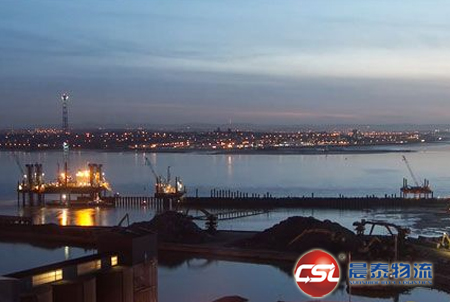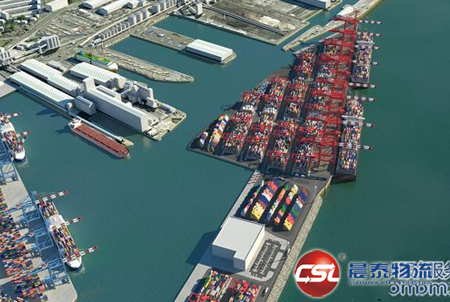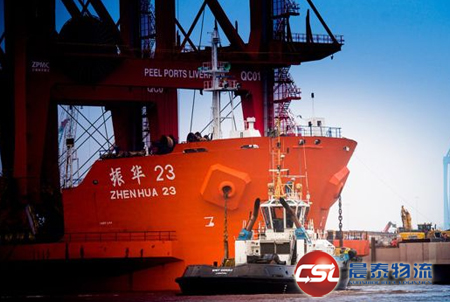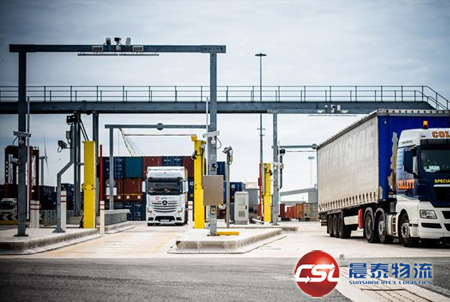Information center
News
| The Rebirth of the Port of Liverpool |
| Source: | Date:2016-05-06 | Browse number: |
Recently, CNSS (en.cnss.com.cn ) interviewed Mr. Jeremy Masters, the Regional Director, Asia Pacific, for Peel Ports. In the interview, Mr. Jeremy Masters introduced the Liverpool2’s construction progress and development strategies of Liverpool2 and future proofing.
Jeremy Masters Regional Director, Asia Pacific, Peel Ports Liverpool2 is set to be a significant Atlantic gateway to Europe for Chinese trade Mr. Jeremy Masters told CNSS that, Liverpool2’s construction is progressing very well and the first five ship-to-shore cranes made in China by ZPMC have been installed and are currently in advanced stages of commissioning. Liverpool2 will have a phased opening throughout 2016, beginning in Q2. This will begin with marine trials in the spring with other aspects of the terminal coming online in the coming months.
Construction of Liverpool2 “This is an incredibly exciting time for Peel Ports Group, the Port of Liverpool and the city itself. Today’s trading environment is far more globalized than it ever has been and with container vessels increasing in size and capability, we understand that they need an attractive efficient entry point to the UK market for import and export.” Mr. Jeremy Masters said. As a new deep water container terminal, Liverpool2 will be the UK’s most central gateway, accommodating direct global services to the heart of the UK. Mr. Jeremy Masters stressed that Peel Ports’ £300m investment in Liverpool2 will double the size of the existing container facilities in the Port of Liverpool allowing them to meet market expectations and enhance their competitive position. Unique Competitive Advantages and Challenge With first rate connectivity to the North of England, Scotland and Ireland, Liverpool2 will be the UK’s most central deep-water terminal, closer to the consumption points than Felixstowe, London Gateway or Southampton ports. There are 35 million consumers within 150 miles of Liverpool2, that over half the UK population. Liverpool can also offer a unique all-water route to the heart of the UK via the Manchester Ship Canal, a 12-terminal, 36-mile long seaway linking the major cities of Liverpool and Manchester. It provides a ‘green highway’ into the heart of the country, carrying around 6.5 million tonnes of cargo a year, removing freight from overcrowded roads and rail.
Effect design of Liverpool2 Peel Ports Group has embarked on a major investment programme, investing in warehousing and distribution facilities to provide a streamlined ship-to-door service for cargo owners. One of these investments is Port Salford. As an ancient port with 300 years history and the largest port in Peel Ports Group’s portfolio, the Port of Liverpool accounts for much of the Group’s turnover and currently handles a diverse range of cargo, including bulk solids and liquids, RORO and containers. One of the key features of the current container terminal is that it is accessed via lock gates which limit the vessel capacity to around 4000 TEU. This is approximately the same width and depth of the Panama Canal pre-expansion. Peel Portsrealized that without action, the majority of vessels deployed on the key trade lanes would not fit into the existing Port of Liverpool. They had to devise a solution to accommodate some of the world’s largest container ships. Liverpool2, built outside of these lock-gates, is the answer to that challenge. As well as being vital to the continued success to the port, the new terminal is also strategically important for the UK as a whole and all those who trade with it. Presently, 90% of all deep-sea containers currently enter the UK through the South, however more than 50% of the demand for the cargo in containers comes from the North. Added to this, a shortage of rail capacity, road hauliers and traffic congestion the UK is severely impacting on reliability, delivery times and cost. The Significance of “Belt And Road” Initiative As to Chinese “Belt And Road” initiative, Mr. Jeremy Masters thought that it has undoubtedly brought more import, export and investment opportunities to Europe and the rest of the world since its introduction in late 2013. The north of Britain accounts for 45% of all UK imports from China and 71% of all UK exports to China, and building on this Liverpool2 is set to be a significant Atlantic gateway to Europe for Chinese trade. With China increasing its infrastructure investment and economic zones within coastal cities, there are increased opportunities to strengthen cooperation between continents and for further trade with British companies. Win-Win Cooperation In recent years, the cooperation between ports around the world becomes more and more frequent, and many ports have established strategic partner relationship. Peel Ports also values relationships with overseas ports – particularly where they allow an exchange of information on technological and infrastructure issues that are mutually beneficial. Mr. Jeremy Masters mentioned that Chinese ports are amongst the most modern and well equipped in the world and have grown at a rapid pace so he thought there is a lot for them to learn from. Coping with Industry Downturn and Container Ship Maximization It is very rare that the port itself is ever the origin or the destination of cargo in a supply chain. It is simply the point where it switches from one mode (water) to another (road / rail). Confronted with the downturn in shipping industry and the decline in port throughput growth, Peel Ports Group’s strategy is to focus on how Liverpool adds value to the total journey.
First five STS cranes have been installed and are in the stages of commissioning Shipping is, per tonne/km, the cheapest and greenest form of transport. By building the right port infrastructure close to the origin or point of consumption, supported by products and services that add value and remove cost, the port of Liverpool uniquely focus on creating supply chain value for the total journey, rather simply on the commoditized services offered by other ports. “Our unique strategy is based firmly on our location and proximity to market, which none of our UK competitor ports can offer. We also offer better transport connectivity, the Manchester Ship Canal inland waterway and the wider logistics support that is important as shippers look for integration and efficiencies throughout their supply chain.”Mr. Jeremy Masters stated. Liverpool2 will be one of the most advanced and modern terminals in the world once fully open. Peel Ports will complement their investment in infrastructure and technology with the best customer service and information sharing possible, as these are key to predictable, reliable and repeatable supply chain operations. In recent years, the containerized vessels are getting to a tendency of great size and large tonnage, which is the main driver of Liverpool’s decision to create the new terminal. They have increased the channel depth in the River Mersey and created a new quay wall outside of the existing locked terminal. This will allow the port of Liverpool to accommodate new Panamax-classified vessels of up to 49m beam and 15m draft to call at the port. Peel Ports has invested in £100 million in 8 ship-to-shore megamax quay cranes and 22 cantilever rail-mounted gantry cranes. Larger ships also bring greater pressure to the landside operation of a port. This can cause delays for local road and rail networks which don’t have the capacity to cope. By being closer to the point of consumption, drivers can complete multiple trips in a day and therefore can evacuate a large container exchange far faster than ports that are more remote from the origin or destination. Automation Technology and Smart Infrastructure for Enhancing Competitiveness
AutoGates at Port of Liverpool Speaking of the current development and competition situation among ports around the world, Peel Ports’ Regional Director considered that the container terminal industry has been generally slow to adopt automation, despite the technologies being advanced, proven and capable of delivering reliable operational efficiency. Liverpool2 has been developed using the latest automation technology, differentiating itself from the competition. The Port of Liverpool has invested in a new terminal operating system and 10-lane AutoGates. This £9.7 million information systems platform is already delivering faster turnaround times through a streamlined process from landside or quayside entry to exit. This combination of infrastructure and technology will reduce the time taken to transfer containers from port to road or rail, helping the Port of Liverpool to achieve targets of 65% of haulage turned round in 30 minutes and 95% of haulage turned in 60 minutes. Peel Ports’ logistics infrastructure further extends to coastal shipping, or the use of inland waterways, a great alternative to countries facing congestion within their road and rail networks such as China, improving hinterland connectivity in a cost effective manner. “The wider adoption of this type of integrated automation technology and smart infrastructure throughout the shipping world will certainly increase global port throughput rankings as we look beyond 2016.” Mr. Jeremy Masters concluded. |
|
Prev:China Establishes Its Silk Road in Greece by Purchasing the Port of Piraeus |

About us | Service | Recruitment | Contact us | Sitemap
Add:F6 NanHai Oil Building NO.28 JiangNan Xi Road GuangZhou China
Tel:(0086)20-8426 2699 Fax:(0086)20-8426 2515





